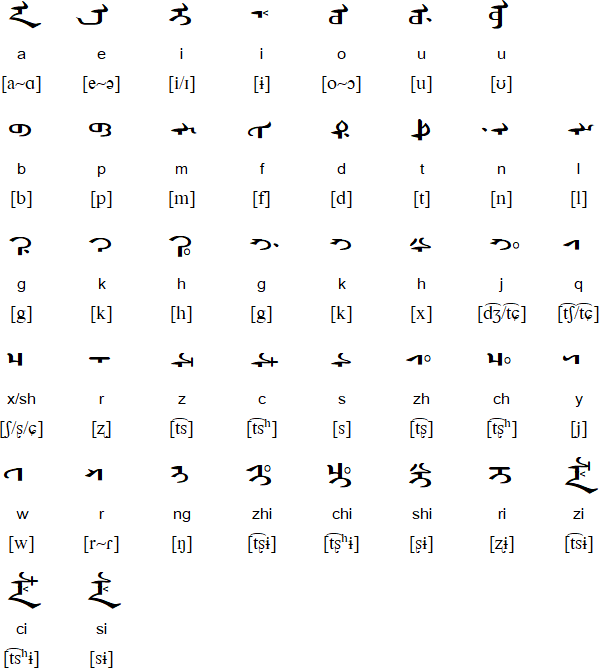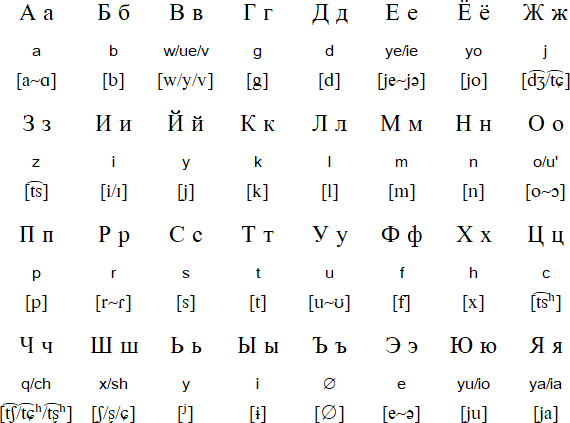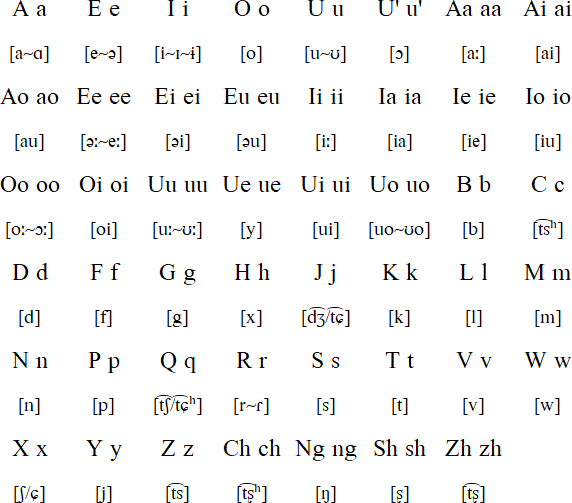Daur is a Mongolic language spoken in northern China and parts of Mongolia. In China it is spoken in Hailar District in Inner Mongolia Autonomous Region, in Qiqhar Prefecture in Heilongjiang Province, and in Tacheng Prefecture in Xinjiang Uyghur Autonomous Region. It is also spoken in Hentiy Province (Хэнтий аймаг) in the northeast of Mongolia.
In 1999 there were about 96,000 speakers of Daur, which is also known as Daghur, Daurian, Daguor, Dagur, Dawar, Dawo'er, Tahuerh or Tahu. Dialects of Daur include Buteha, Qiqiha'er, Haila'er and Ili.
Daur has no standard written form, but a version of Pinyin is sometimes used. During the Qing Dynasty (1636-1912) the Manchu alphabet was used to write Daur. The Cyrillic alphabet has also been used to write Daur.



Details of Daur alphabets provided by Michael Peter Füstumum
Download alphabet charts for Daur (Excel)
Information about Daur | Numbers
Information about the Daur language
https://en.wikipedia.org/wiki/Daur_language
https://fr.wikipedia.org/wiki/Daur_(langue)
https://zh.wikipedia.org/wiki/达斡尔语
https://www.ethnologue.com/18/language/dta/
http://glottolog.org/resource/languoid/id/daur1238
Alasha, Barin, Buryat, Chakhar, Daur, Jarud, Kalmyk, Khamnigan Mongol, Khorchin, Mogholi, Mongolian, Monguor, Santa / Dongxiang
Abaza, Abkhaz, Adyghe, Aghul, Akhvakh, Akkala Sámi, Aleut, Altay, Alyutor, Andi, Archi, Assyrian / Neo-Assyrian, Avar, Azeri, Bagvalal, Balkar, Bashkir, Belarusian, Bezhta, Bosnian, Botlikh, Budukh, Bulgarian, Buryat, Chamalal, Chechen, Chelkan, Chukchi, Chulym, Chuvash, Crimean Tatar, Dargwa, Daur, Dolgan, Dungan, Enets, Erzya, Even, Evenki, Gagauz, Godoberi, Hinukh, Hunzib, Ingush, Interslavic, Itelmen, Juhuri, Kabardian, Kaitag, Kalderash Romani, Kalmyk, Karaim, Karakalpak, Karata, Karelian, Kazakh, Ket, Khakas, Khanty, Khinalug, Khorasani Turkic, Khwarshi, Kildin Sámi, Kili, Komi, Koryak, Krymchak, Kryts, Kubachi, Kumandy, Kumyk, Kurdish, Kyrgyz, Lak, Lezgi, Lingua Franca Nova, Lithuanian, Ludic, Macedonian, Mansi, Mari, Moksha, Moldovan, Mongolian, Montenegrin, Nanai, Negidal, Nenets, Nganasan, Nivkh, Nogai, Old Church Slavonic, Oroch, Orok, Ossetian, Pontic Greek, Romanian, Rushani, Russian, Rusyn, Rutul, Selkup, Serbian, Shor, Shughni, Siberian Tatar, Sirenik, Slovio, Soyot, Tabassaran, Tajik, Talysh, Tat, Tatar, Teleut, Ter Sámi, Tindi, Tofa, Tsakhur, Tsez, Turkmen, Tuvan, Ubykh, Udege, Udi, Udmurt, Ukrainian, Ulch, Urum, Uyghur, Uzbek, Veps, Votic, Wakhi, West Polesian, Xibe, Yaghnobi, Yakut, Yazghulami, Yukaghir (Northern / Tundra), Yukaghir (Southern / Kolyma), Yupik (Central Siberian)
Languages written with the Latin alphabet
Page last modified: 22.02.22
[top]
You can support this site by Buying Me A Coffee, and if you like what you see on this page, you can use the buttons below to share it with people you know.

If you like this site and find it useful, you can support it by making a donation via PayPal or Patreon, or by contributing in other ways. Omniglot is how I make my living.
Note: all links on this site to Amazon.com, Amazon.co.uk
and Amazon.fr
are affiliate links. This means I earn a commission if you click on any of them and buy something. So by clicking on these links you can help to support this site.
[top]